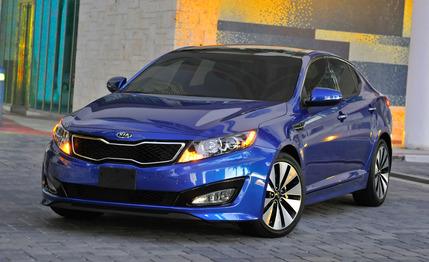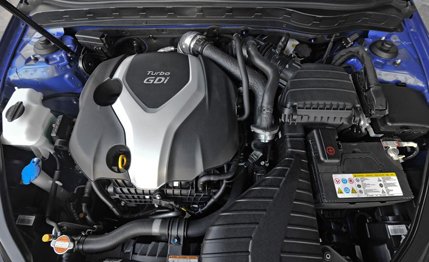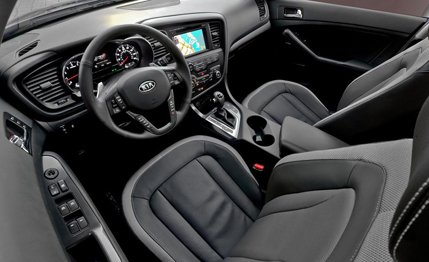 Short Take Road Test
Short Take Road Test
What Is It?
The turbocharged top-spec version of the handsome new Kia Optima, which shares its powertrain lineup and architecture with the 10Best-winning Hyundai Sonata. The SX comes pretty well stocked, including the direct-injected 2.0-liter turbo four, 18-inch wheels with black-painted pockets, HID headlamps, LED taillights, dual-zone auto climate control, Bluetooth, an LCD in the instrument panel, leather upholstery, and racy body bits. If you’d like your blown Optima to be less furious-looking—yes, we just called a Kia “furious-looking”—and $1500 cheaper, the EX turbo is your car; it skips the sporty stuff everywhere but under the hood.
How Does It Drive?
Whatever the trim, the Optima is a fine-driving family sedan, and it has more of an enthusiast bent than does the excellent Sonata. The hefty steering is accurate, turn-in response is quick, and the suspension keeps a tight rein on body motions over bumps and during transient maneuvers. All Optimas have a suspension that can be described as firm, but the SX’s firmer dampers go another notch. The setup can make for a chopped, harsh ride; you might consider the Hyundai—or at least a lesser Optima—if you live anywhere with crappy roads.

The 274-hp, 2.0-liter turbo four with 269 lb-ft of torque is silky smooth and punches hard enough to send the 3500-pound Optima to 60 mph in 6.4 seconds and through the quarter in 15 flat. Turbo response is basically seamless, which is excellent for drivability but bad if you want to stay out of it to improve fuel economy—we achieved 20 mpg with our Optima, below the 22 mpg city and 34 mpg highway EPA ratings. The six-speed automatic shifts smoothly, and the SX has steering-wheel-mounted paddles if you feel like playing F1 on the way to Froyo.
How Does It Stack Up?
Like the Sonata, the Optima proves that you don’t need a V-6 to have a good time. This turbo is among the quickest in its class; a 272-hp V-6 Mazda 6 and a turbo Sonata were quicker, at 6.1 and 6.2 seconds to 60. (The Mazda weighed some 70 more pounds than this Kia, and the Sonata weighed 110 fewer.) But the design and materials in the Optima’s cabin are a step above the Mazda’s, as well as those of most of the Kia’s competition. The crisp exterior looks more upscale than most mid-size sedans’ and isn’t too polarizing—the latter is key for this segment. We also really like cool details such as the cutout at the top of the windshield that echoes Kia’s corporate grille.

For those who like to drive, the Optima and the 6 are the most satisfying mid-size sedans, with the Honda Accord and Sonata just behind. Relative to that lot, everything else in the segment is automotive applesauce.
What’s the Cost?
Our whole-hog Optima test car rang in at $30,840, which consisted of the $26,690 base price plus the $2000 Technology and $2150 Premium Touring packages. The latter includes a big sunroof, a power front-passenger seat, driver’s-seat memory, heated and cooled front seats, heated rear seats, and different 18-inch wheels. (If you prefer the look of the standard rollers, you can spec a Premium package without new wheels for the same $2150.) Ordering the Premium upgrades is a must to get the Tech pack, which adds a nav system, a rearview camera, and an upgraded Infinity stereo. A V-6 Accord or a six-cylinder Ford Fusion outfitted like our Optima SX would cost at least an additional $1900; value is still a significant part of the Kia equation. Taken with the rest of the car, that adds up to a winner in our book.